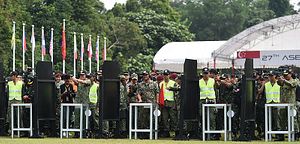This week, ASEAN army intelligence chiefs, military officials, and experts gathered in Singapore for the first iteration of a new information sharing workshop that was formally agreed to last year. The workshop, which was focused this year on the threats posed by terrorism and chemical, biological, and radiological weapons, once again put the spotlight on regional efforts underway to counter transnational challenges.
As I have noted before in these pages, Southeast Asian states have a variety of defense engagements between them within the ASEAN framework, including gatherings of officials from various services. One of these is the ASEAN Chiefs of Army Multilateral Meeting (ACAMM), which was first held in Thailand in 2000.
One of the initiatives that came out of the last round of ASEAN army meetings last year was the holding of an ASEAN Armies Information Sharing Workshop (AAISW). AAISW was included as an item in the joint declaration issued by the army chiefs focused on addressing transnational threats, and Singapore was to host the inaugural workshop this year as the holder of the annually rotating ASEAN chairmanship (See: “What Are ASEAN’s Defense Priorities During Singapore’s Chairmanship in 2018?”).
From July 3 to July 5, as had been anticipated, Singapore hosted the inaugural iteration of the new AAISW. The workshop, which was held at the Grand Copthorne Waterfront Hotel, featured over 100 delegates including army intelligence chiefs, military delegates, and other experts.
The inaugural AAISW was focused around the theme of strengthening cooperation against regional terrorism and chemical, biological, and radiological (CBR) threats. The theme was in line with the issues of concern for Southeast Asian states, particularly given the heightened concerns about terror groups following the Marawi siege in the Philippines last year and the North Korea issue (See: “ASEAN’s Post-Marawi Islamic State Challenge”). It was also in line with the focus areas that Singapore had put forth on the defense side for its ASEAN chairmanship this year, including its Resilience-Response-Recovery framework as a comprehensive approach to tackling threats.
The workshop itself featured two plenary sessions, a roundtable discussion, and other activities including a demonstration of the SAF’s capabilities in responding to terror and CBR threats. According to Singapore’s defense ministry (MINDEF), sessions saw presentations from officials as well as experts, including Lieutenant General Rolando Bautista, the chief of the Philippine Army, who shared an account of the lessons that the Philippine Army had internalized following the Marawi conflict during the first plenary session.
Bautista, who was on his introductory visit to Singapore, also met separately with a range of Singapore officials including Defense Minister Ng Eng Hen and discussed bilateral defense ties. As I have noted before in these pages, one aspect of that defense relationship has been the role Singapore has been playing in boosting Philippine capabilities following the Marawi crisis, including through not just assistance but also training in urban operations.

































